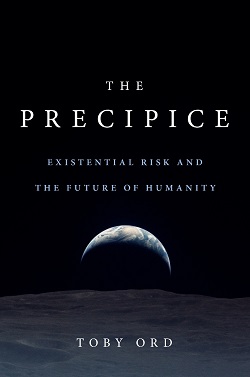
Cryonics is the low-temperature freezing and storage of human remains in the hope that resurrection may be possible in the future. Cryonics is regarded with skepticism by the mainstream scientific community. It is generally viewed as a pseudoscience, and its practice has been characterized as quackery.

Transhumanism is a philosophical and intellectual movement that advocates the enhancement of the human condition by developing and making widely available new and future technologies that can greatly enhance longevity, cognition, and well-being.

Mind uploading is a speculative process of whole brain emulation in which a brain scan is used to completely emulate the mental state of the individual in a digital computer. The computer would then run a simulation of the brain's information processing, such that it would respond in essentially the same way as the original brain and experience having a sentient conscious mind.
Extropianism, also referred to as the philosophy of extropy, is an "evolving framework of values and standards for continuously improving the human condition". Extropians believe that advances in science and technology will some day let people live indefinitely. An extropian may wish to contribute to this goal, e.g. by doing research and development or by volunteering to test new technology.

David Pearce is a British transhumanist philosopher. He is the co-founder of the World Transhumanist Association, currently rebranded and incorporated as Humanity+. Pearce approaches ethical issues from a lexical negative utilitarian perspective.

Nick Bostrom is a philosopher known for his work on existential risk, the anthropic principle, human enhancement ethics, whole brain emulation, superintelligence risks, and the reversal test. He was the founding director of the now dissolved Future of Humanity Institute at the University of Oxford and is now Principal Researcher at the Macrostrategy Research Initiative.

James J. Hughes is an American sociologist and bioethicist. He is the Executive Director of the Institute for Ethics and Emerging Technologies and is the associate provost for institutional research, assessment, and planning at UMass Boston. He is the author of Citizen Cyborg: Why Democratic Societies Must Respond to the Redesigned Human of the Future and is currently writing a book about moral bioenhancement tentatively titled Cyborg Buddha: Using Neurotechnology to Become Better People.

Morphological freedom refers to a proposed civil right of a person to either maintain or modify their own body, on their own terms, through informed, consensual recourse to, or refusal of, available therapeutic or enabling medical technology.
The Institute for Ethics and Emerging Technologies (IEET) is a technoprogressive think tank that seeks to "promote ideas about how technological progress can increase freedom, happiness, and human flourishing in democratic societies." It was incorporated in the United States in 2004, as a non-profit 501(c)(3) organization, by philosopher Nick Bostrom and bioethicist James Hughes.

Human extinction is the hypothetical end of the human species, either by population decline due to extraneous natural causes, such as an asteroid impact or large-scale volcanism, or via anthropogenic destruction (self-extinction), for example by sub-replacement fertility.
Many of the tropes of science fiction can be viewed as similar to the goals of transhumanism. Science fiction literature contains many positive depictions of technologically enhanced human life, occasionally set in utopian societies. However, science fiction's depictions of technologically enhanced humans or other posthuman beings frequently come with a cautionary twist. The more pessimistic scenarios include many dystopian tales of human bioengineering gone wrong.

Natasha Vita-More is a strategic designer in the area of human enhancement and life extension. Her interests are located within the ethical uses of science and technology and socio-political implications of revolutionary advances impacting humanity's future.

The Future of Humanity Institute (FHI) was an interdisciplinary research centre at the University of Oxford investigating big-picture questions about humanity and its prospects. It was founded in 2005 as part of the Faculty of Philosophy and the Oxford Martin School. Its director was philosopher Nick Bostrom, and its research staff included futurist Anders Sandberg and Giving What We Can founder Toby Ord.

A global catastrophic risk or a doomsday scenario is a hypothetical event that could damage human well-being on a global scale, even endangering or destroying modern civilization. An event that could cause human extinction or permanently and drastically curtail humanity's existence or potential is known as an "existential risk".

Toby David Godfrey Ord is an Australian philosopher. In 2009 he founded Giving What We Can, an international society whose members pledge to donate at least 10% of their income to effective charities, and is a key figure in the effective altruism movement, which promotes using reason and evidence to help the lives of others as much as possible.

Transhumanist politics constitutes a group of political ideologies that generally express the belief in improving human individuals through science and technology. Specific topics include space migration, and cryogenic suspension. It is considered the opposing ideal to the concept of bioconservatism, as Transhumanist politics argue for the use of all technology to enhance human individuals.

The Precipice: Existential Risk and the Future of Humanity is a 2020 non-fiction book by the Australian philosopher Toby Ord, a senior research fellow at the Future of Humanity Institute in Oxford. It argues that humanity faces unprecedented risks over the next few centuries and examines the moral significance of safeguarding humanity's future.

Longtermism is the ethical view that positively influencing the long-term future is a key moral priority of our time. It is an important concept in effective altruism and a primary motivation for efforts that aim to reduce existential risks to humanity.
Existential risk studies (ERS) is a field of studies focused on the definition and theorization of "existential risks", its ethical implications and the related strategies of long-term survival. Existential risks are diversely defined as global kinds of calamity that have the capacity of inducing the extinction of intelligent earthling life, such as humans, or, at least, a severe limitation of their potential, as defined by ERS theorists. The field development and expansion can be divided in waves according to its conceptual changes as well as its evolving relationship with related fields and theories, such as futures studies, disaster studies, AI safety, effective altruism and longtermism.
"Letter from Utopia" is a fictional letter written by philosopher Nick Bostrom in 2008. It depicts, what Bostrom describes as, "A vision of the future, from the future". In the essay, a posthuman in the far future writes to humanity in the deep past, describing how wonderful their utopian existence is and encouraging their ancestors to do everything they can to make their future possible. This includes conquering aging, sickness, and death, increasing human intelligence, and eliminating suffering in pursuit of pleasure. The essay is considered a manifesto of transhumanism.















